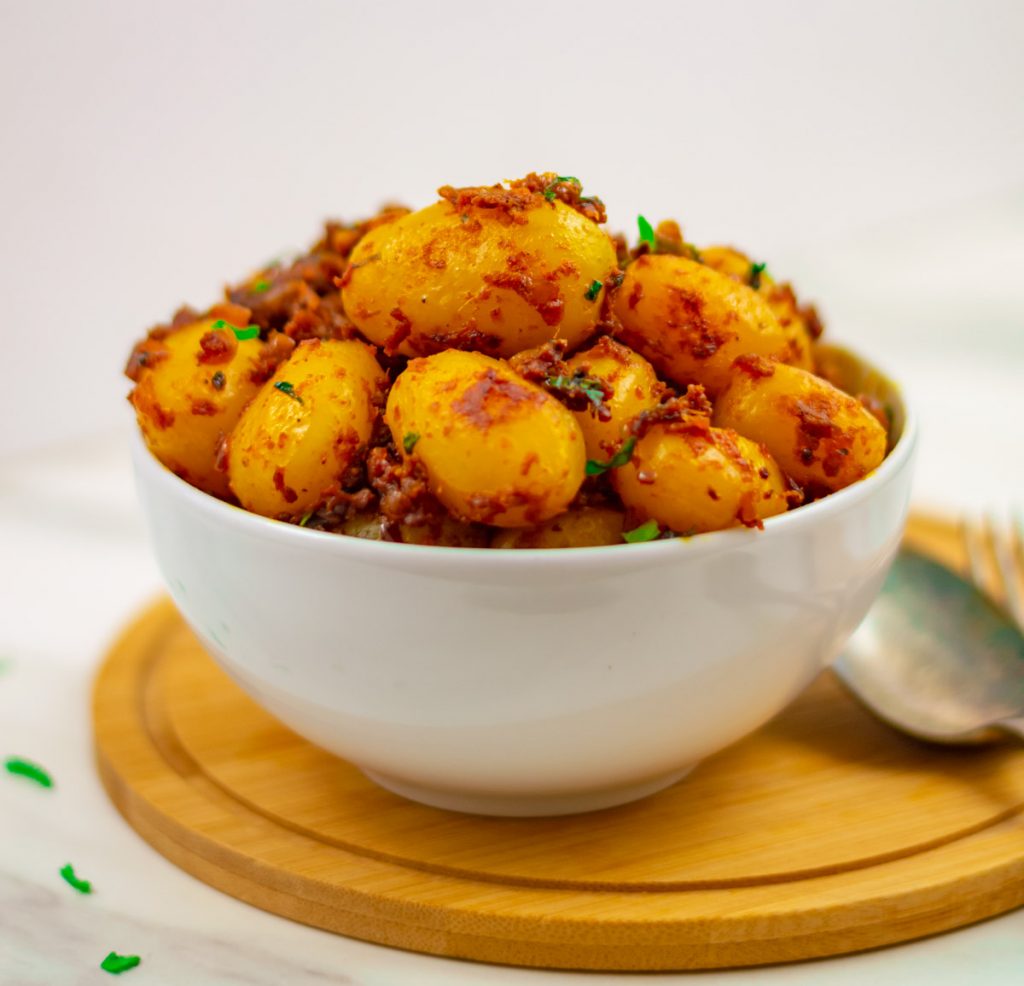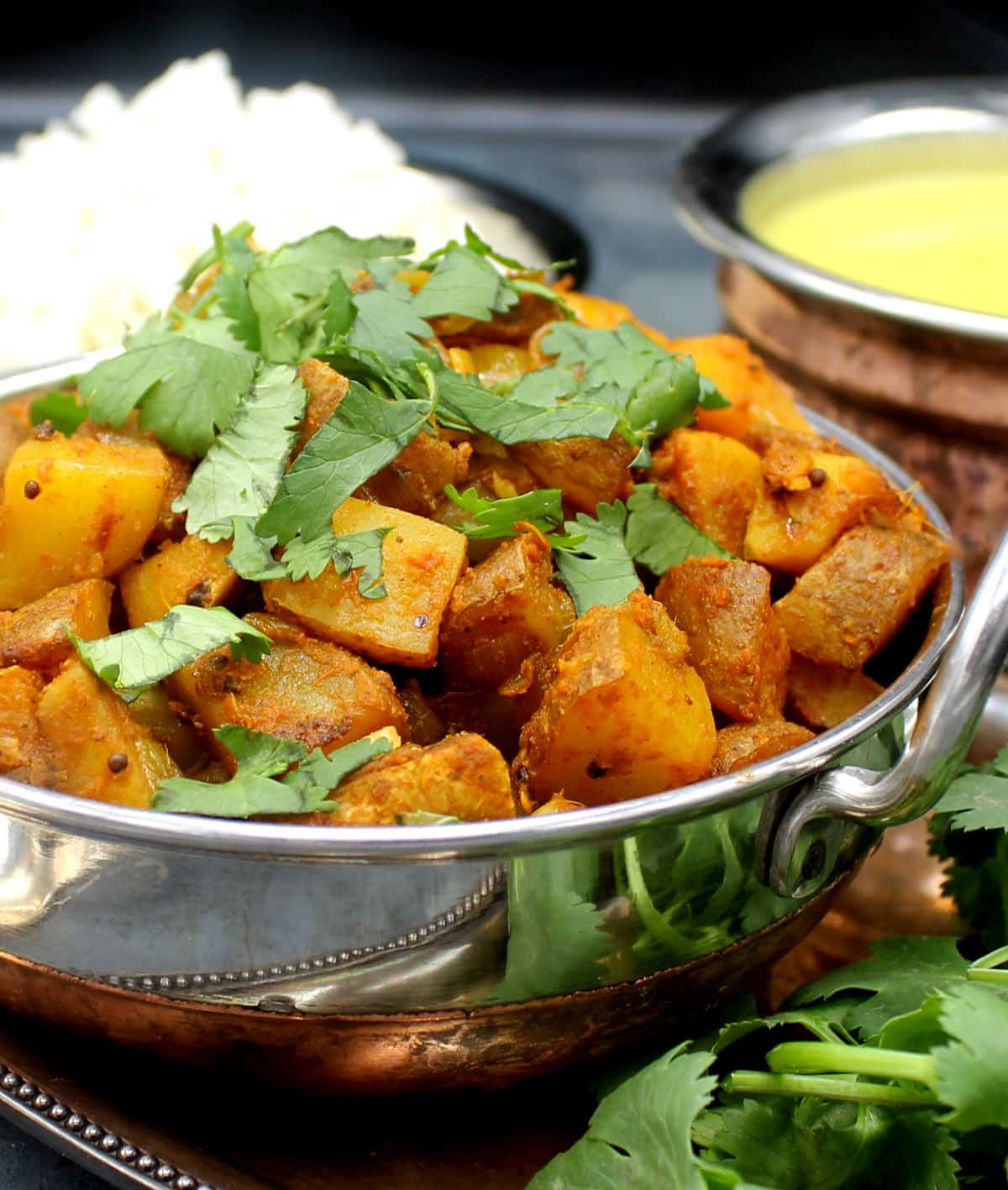These easy, tasty Bombay Potatoes are simply spiced with curry powder and pan-fried with tomatoes until they develop a delicious, golden-brown crust. They pack a wallop of flavor and they are a great vegetable side to serve with any Indian meal, especially dal and rice.
I was born and lived in Bombay into my 20s, but in all those years I never once encountered a dish named “Bombay Potatoes.”
So when I started to see recipes for Bombay Potatoes begin to pop up across the internet with no clear explanation of their origin but with quintessentially Indian ingredients, I was tickled curious.
Sure, we ate potatoes in Bombay–a lot. Bombay is a microcosm of India and you could find all kinds of potato dishes belonging to the many regional cuisines here. There was Batatyachi Bhaji, a local Maharashtrian, turmeric-stained, mustard-seed-studded side to scoop up with pooris, especially on picnics and outings. Jeera Aloo, a north Indian dish with cumin seeds as their main flavoring. A south Indian potato curry with tomatoes and sambar powder that was eaten in the homes of my Tamil friends in Bombay and that, Desi tells me, was a Sunday staple in his childhood home in Madras. There were the typical restaurant offerings: aloo gobi, aloo matar, aloo saag….but never Bombay potatoes.
What was just as confusing is that the various Bombay Potato recipes on the web seem to vary drastically. Some are just Jeera Aloo, others are almost exactly like Batatyachi Bhai. Still others use tomatoes, like the South Indian version.
Since I cant leave things well alone when they pique my interest, I kept digging into this until I could begin to make some sense. What seems very likely, although I didnt find a single source confirming this, is that Bombay potatoes — or at least the name — are British rather than Indian in origin.
It makes sense. The British introduced potatoes to India during colonial times, were rather chuffed about it because they were on a mission to introduce the rest of us to what they deemed “superior” vegetables, and then they took our chefs back home with them to spice up their own cuisine. These cooks went on to create a whole slew of dishes that have roots in India but were created in Britain, like balti, tikka masala, kedgeree and curry powder.
The Bombay Potato curry, then, is not so much an Indian potato recipe but rather a spin-off — or amalgamation–of different techniques and flavors used to cook potatoes in India. That different Bombay Potato recipes have little in common except the fact that they have potatoes in them and are made with Indian ingredients is further confirmation of the fact that while the actual dish — or dishes grouped under the name — may have originated in India, the name almost definitely did not.
Id love to know more, so if you happen to be an expert on Bombay Potatoes and their beginnings, be sure to drop a comment below and enlighten the rest of us.
Now, for these Indian-spiced Bombay Potatoes. I put my own spin on these and I think youll love them. I simmered the potatoes with tomatoes because these two veggies are an incredible combination, especially when you let the tomatoes cook long enough to crust the potatoes. And then I used curry powder because its flavor is perfect here and because it, too, is so confoundingly British.

How to make Bombay Potatoes
- Most Bombay Potato recipes ask you to start out by parboiling or boiling the potatoes first. I prefer not to do that for this recipe where we want the potatoes to cook with the tomatoes and develop that nice crust. Parboiling the potatoes will just make them soft and mushy and while that can be nice in a jeera aloo or batatyachi bhaji, it wont work here.
- The happy effect of this is it makes this recipe one-pot as well.
- Start out your recipe by sputtering mustard seeds in coconut oil in a wok or large skillet, and then sauteing shallots in that mustard-flavored oil until they are just slightly soft. You can use red onions but I like using shallots which more closely resemble local Indian onions, with a bolder flavor. There are so few ingredients in this recipe, you want to extract all the flavor from each element that goes into your pot.
- Dont cook the shallots too long by themselves. The reason for this is that they will continue to cook with the potatoes, and if you brown them too much at this stage they will overcook and probably burn.
- Add turmeric and grated ginger to the pot and saute quickly for a few seconds. Add the potatoes, cut in a small dice, to the skillet along with salt and saute. You want the potatoes to be small because we are adding them raw and they are going to cook entirely in the skillet.
- Put a lid on the skillet or wok and let the potatoes cook, over medium to low heat, until they are about halfway done. Stir the potatoes frequently to make sure they are not sticking to the bottom. A nonstick wok or skillet makes this much easier.
- Add the tomato puree to the pot along with the cayenne and curry powder. Mix well, maintain heat at medium to low, and cover. Check frequently and stir. Some potatoes might stick a bit to the bottom, which is fine, because that will help them become crusty. Dont let them burn, though.
- Once the potatoes are tender, take the lid off and let the potatoes continue cooking for another two minutes. Stir frequently so nothing stays at the bottom of the pot for too long. Check salt and turn off heat.
- Garnish with cilantro and serve hot.
Why you’ll love this recipe
- Its easy. Theres almost no skill or expertise required to make these Bombay potatoes.
- Its delicious. Potatoes and spices. Need I say more?
- Its healthy. Potatoes can be incredibly waist-friendly, if they are not smothered in oil or butter. In this recipe the natural healthfulness of potatoes gets an additional boost from the flavorful spices.
- Its kid-friendly. Kids and potatoes. Its like peas and carrots, except in this case one eats the other.
- It needs just nine easy ingredients. And most of these you likely already have in your pantry.
- Its one-pot. Easy cleanup. What more can you ask for?
- Coconut oil: Coconut oil is a great flavoring agent in south Indian style recipes like this one, in addition to being a medium for cooking.
- Mustard seeds: Black mustard seeds, as always, in Indian cooking. Sputter in the oil.
- Shallots (finely diced). I advise using shallots, when possible, in Indian dishes where the onions provide flavor, like this one. Indian onions are small and red, much like shallots, and the flavor works perfectly. If you cant source shallots, use red onions.
- Ginger. Grate before use.
- Turmeric: For color and health.
- Potatoes. Yellow or red potatoes are fine but dont use russets or any starchy potato.
- Tomato puree. You can use canned or puree fresh tomatoes.
- Cayenne. For heat and color.
- Curry powder. Use my homemade recipe linked here, or use a storebought powder you like. Taste and use more if you wish.
- Salt to taste
- Cilantro. This is for garnish, and optional.

Bombay Potatoes | Spiced Indian Potatoes
FAQ
Where did Bombay potatoes come from?
|
Alternative names
|
Bombay aloo, Aloo or Alu Bombay
|
|
Course
|
Main or Side dish
|
|
Place of origin
|
India
|
|
Main ingredients
|
Potato, cumin, curry, garlic, garam masala, turmeric, mustard seeds, chilli powder, salt and pepper
|
What is Bombay potato?
Bombay potato (sometimes called Bombay aloo or aloo ( alu) Bombay ), is an Indian dish prepared using potatoes that are cubed, parboiled and then fried and seasoned with various spices such as cumin, curry, garlic, garam masala, turmeric, mustard seeds, chili powder, salt and pepper.
How to make Bombay potato curry?
Call them Bombay potatoes. Or Bombay aloo. Either way it’s one seriously delicious potato curry. Make the spice mix. Combine all the spice mix ingredients in a small bowl. Dilute the tomato paste with the water. Cook the potatoes. Combine the potatoes, turmeric and salt along with enough water to cover. Bring to a boil.
How to cook Bombay potatoes?
Cover the pan and cook over a medium heat for 10 minutes to develop the flavours. When you lift the lid, your bombay potatoes are ready to serve. Season with salt and pepper to taste and garnish with the chopped coriander (cilantro). Sprinkle in the garam masala. Serve hot as a side or main dish over rice.
Why are Bombay potatoes called aloo Subzi?
Bombay potatoes (or Bombay Aloo) get their name from the British. The British Raj introduced potatoes to India to replace indigenous vegetables with “superior” plants. At home, we just call them ‘aloo subzi’ (aloo means potato and subzi refers to a sauté of vegetables).
